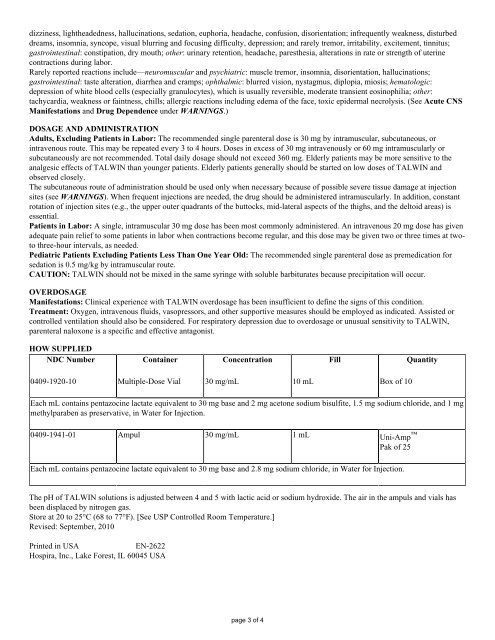Pentazocine - American Geriatrics Society
Pentazocine - American Geriatrics Society
Pentazocine - American Geriatrics Society
You also want an ePaper? Increase the reach of your titles
YUMPU automatically turns print PDFs into web optimized ePapers that Google loves.
dizziness, lightheadedness, hallucinations, sedation, euphoria, headache, confusion, disorientation; infrequently weakness, disturbed<br />
dreams, insomnia, syncope, visual blurring and focusing difficulty, depression; and rarely tremor, irritability, excitement, tinnitus;<br />
gastrointestinal: constipation, dry mouth; other: urinary retention, headache, paresthesia, alterations in rate or strength of uterine<br />
contractions during labor.<br />
Rarely reported reactions include—neuromuscular and psychiatric: muscle tremor, insomnia, disorientation, hallucinations;<br />
gastrointestinal: taste alteration, diarrhea and cramps; ophthalmic: blurred vision, nystagmus, diplopia, miosis; hematologic:<br />
depression of white blood cells (especially granulocytes), which is usually reversible, moderate transient eosinophilia; other:<br />
tachycardia, weakness or faintness, chills; allergic reactions including edema of the face, toxic epidermal necrolysis. (See Acute CNS<br />
Manifestations and Drug Dependence under WARNINGS.)<br />
DOSAGE AND ADMINISTRATION<br />
Adults, Excluding Patients in Labor: The recommended single parenteral dose is 30 mg by intramuscular, subcutaneous, or<br />
intravenous route. This may be repeated every 3 to 4 hours. Doses in excess of 30 mg intravenously or 60 mg intramuscularly or<br />
subcutaneously are not recommended. Total daily dosage should not exceed 360 mg. Elderly patients may be more sensitive to the<br />
analgesic effects of TALWIN than younger patients. Elderly patients generally should be started on low doses of TALWIN and<br />
observed closely.<br />
The subcutaneous route of administration should be used only when necessary because of possible severe tissue damage at injection<br />
sites (see WARNINGS). When frequent injections are needed, the drug should be administered intramuscularly. In addition, constant<br />
rotation of injection sites (e.g., the upper outer quadrants of the buttocks, mid-lateral aspects of the thighs, and the deltoid areas) is<br />
essential.<br />
Patients in Labor: A single, intramuscular 30 mg dose has been most commonly administered. An intravenous 20 mg dose has given<br />
adequate pain relief to some patients in labor when contractions become regular, and this dose may be given two or three times at twoto<br />
three-hour intervals, as needed.<br />
Pediatric Patients Excluding Patients Less Than One Year Old: The recommended single parenteral dose as premedication for<br />
sedation is 0.5 mg/kg by intramuscular route.<br />
CAUTION: TALWIN should not be mixed in the same syringe with soluble barbiturates because precipitation will occur.<br />
OVERDOSAGE<br />
Manifestations: Clinical experience with TALWIN overdosage has been insufficient to define the signs of this condition.<br />
Treatment: Oxygen, intravenous fluids, vasopressors, and other supportive measures should be employed as indicated. Assisted or<br />
controlled ventilation should also be considered. For respiratory depression due to overdosage or unusual sensitivity to TALWIN,<br />
parenteral naloxone is a specific and effective antagonist.<br />
HOW SUPPLIED<br />
NDC Number Container Concentration Fill Quantity<br />
0409-1920-10 Multiple-Dose Vial 30 mg/mL 10 mL Box of 10<br />
Each mL contains pentazocine lactate equivalent to 30 mg base and 2 mg acetone sodium bisulfite, 1.5 mg sodium chloride, and 1 mg<br />
methylparaben as preservative, in Water for Injection.<br />
0409-1941-01 Ampul 30 mg/mL 1 mL Uni-Amp <br />
Pak of 25<br />
Each mL contains pentazocine lactate equivalent to 30 mg base and 2.8 mg sodium chloride, in Water for Injection.<br />
The pH of TALWIN solutions is adjusted between 4 and 5 with lactic acid or sodium hydroxide. The air in the ampuls and vials has<br />
been displaced by nitrogen gas.<br />
Store at 20 to 25°C (68 to 77°F). [See USP Controlled Room Temperature.]<br />
Revised: September, 2010<br />
Printed in USA<br />
EN-2622<br />
Hospira, Inc., Lake Forest, IL 60045 USA<br />
page 3 of 4

















